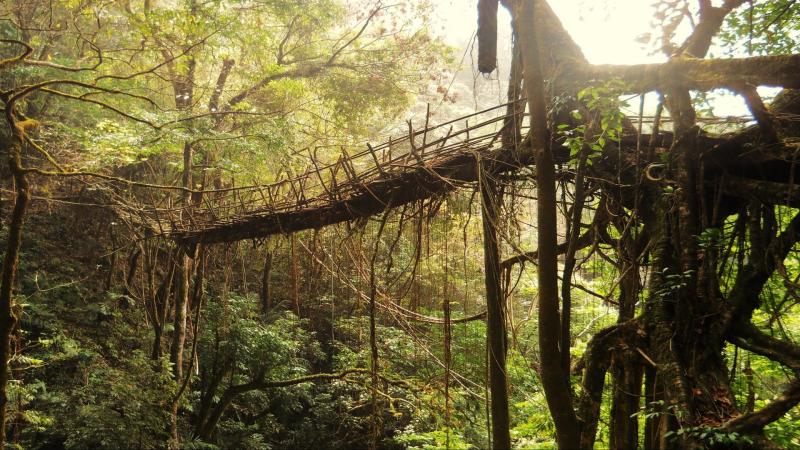
Since 2012, six bridges have collapsed in Mumbai, killing 28 people and injuring hundreds. Often, news of flyovers and pedestrian bridges tumbling down have made it to the headlines across the country. Although durable materials like steel and concrete are used in today’s structures, poor quality of construction and lack of maintenance are often blamed for such catastrophes. Contrast this with the rock-solid centuries-old root bridges found in Meghalaya—many as old as 250 years and still growing strong—built without modern tools or design. Could the structure of these bridges unravel architectural clues for urban construction?
In a recent study, researchers from Germany and the USA have tried to understand the morphology and structure of these root bridges, built out of the aerial roots of strangler figs, and that have endured floods, earthquakes, landslides and fires. The study, published in the journal Scientific Reports, also documents the living root bridges in the Khasi and Jaintia Hills of Meghalaya along with their geolocations, history, maintenance and structural properties.
“The living root bridges are the most abundant form of living architecture in the world and studying them can help us learn how to protect these unique structures,” says Mr Wilfrid Middleton, an author of the study. He works at the Professorship for for Green Technologies in Landscape Architecture at the Technical University of Munich (TUM), Germany. “They can also inform the design of living and structures that mimic these trees elsewhere in rural and urban environments,” he elaborates on the importance of these bridges.
The anatomy of a root bridge
The ‘living root bridges’ are named so because they are ‘built’ by taking advantage of the mechanical strength of the aerial roots of the rubber fig or Ficus elastica. These trees are native to eastern parts of South Asia. They start by growing on the branches of other trees, and when aerial roots develop, these roots grow downwards in the air or along the stem of the host tree. Once the roots find the ground, they start to form a scaffolding around the host tree, prevent its growth and ‘strangle’ it to death.
The Khasi and Jaintia people build these bridges by planting a rubber fig tree on one bank of the river. When the aerial roots develop, they are wound onto and directed across a bamboo structure. Once they reach the other bank, the roots are implanted into the ground, resulting in the shortening and thickening of the roots that are part of the bridge. Daughter roots develop from these parts over time, which are again wound similarly by generations of people, further strengthening the bridge. Sometimes, heavy stones, timber, leaves and soil are added to plug gaps and reinforce the bridge.
There is no lack of creativity in building these bridges—some have handrails, and others have a second deck. There are suspension bridges, arches, beam-supported bridges and cable bridges—all built from roots.
“There has already been a lot of discussion about the living root bridges in the media and blogs, but there have only been a few scientific investigations uptil now,” says Dr Ferdinand Ludwig.
He is an architect and a professor for Green Technologies in Landscape Architecture at TUM, and the corresponding author of the study. With this motivation, the researchers attempted to document the science behind how these bridges are built.
The researchers used photographs, measurements, locations and interviews to gather information on 74 bridges found in the Khasi and Jaintia Hills. They found that all of these bridges were used by people to cross monsoon-swollen rivers to reach other villages, croplands or markets. Although they varied in their lengths, four out of five bridges were less than 20m in length. Most of them were well-maintained by individuals, families or village communities, who regularly removed mosses on the bridges, pruned and tied the roots. Some of the bridges were built about two centuries ago, while others were relatively new.
When the aerial roots of strangler fig trees reach the ground, they produce tension wood—a particular type of wood that forms on the roots in response to the mechanical stress. As a result, the aerial roots shorten and thicken in the process. The tension wood also helps in pressing neighbouring roots with excessive forces, resulting in inosculation—a phenomenon where the roots intertwine with each other and grow together. Mechanical load that act on the bridges shape the growth of secondary daughter roots, which also inosculate with older roots, strengthening the bridge further.
The roots thus formed are strong enough to support the structure for years.
“Just as tall, thin buttress roots provide stability for trees, the specialised roots may provide bending resistance in the bridge deck, just as reinforced concrete does,” explains Mr Middleton.

Inosculation: A young aerial root knotted into a network, which shortens and tightens them. Later the roots will grow together at this point.
[Image credit: Dr Ferdinand Ludwig]
What does the future hold?
The living root bridges represent a specialised structure developed by humans that can last very long.
“The root network also provides support to the surrounding hillside, while the concrete constructions currently booming in Meghalaya often reduce the stability of the hillside,” says Mr Middleton.
The traditional techniques of the Khasi and Jaintia people can also be integrated into our present-day building structures, including the practice of users tending to its maintenance over many years. Besides, the bridge structures may also help build cooler cities when integrated into buildings, as the global climate gets warmer. ‘Baubotanik’, an emerging research area in architecture, focuses on including plants as components of structures, without creating extra space for them.
“Stone, concrete and asphalt heat up rapidly at high ambient temperatures, so that heat stress is particularly relevant in cities. Plants provide cooling and improve the climate in the city,” remarks Dr Ludwig.
While the living root bridges could improvise our future buildings and cities, their own future seems to be in the dark. The influx of tourists, who come to see these structural marvels, has resulted in increased load on the bridges—more than what they are built for. This impacts the subsurface roots that need protection and nourishment.
“In some villages, the bridge receives a footfall of more than a thousand people per day,” says Mr Sanjeev Shankar, an architect and researcher, who has extensively studied these bridges in Meghalaya.
Together with indigenous communities and the Government of Meghalaya, he is investigating how this traditional knowledge can be merged with contemporary practices to nurture positive socio-economic-ecological impact. With unplanned tourism and unregulated footfall, along with the pollution of the surrounding ecosystem, the bridges face serious threats.
Another threat to the bridges is the use of inappropriate building materials, like reinforced cement concrete, burnt bricks, galvanised iron and steel, on and around these bridges. In some regions, parts of the roots are either cut, damaged or overlaid with concrete, destroying the living structure. Concrete bridges, which may not endure the adversity of the terrain and the extreme climate, have replaced some of these bridges.
“With unregulated and unscientific use of inappropriate construction materials, the local root bridge ecosystem can be negatively impacted and slowly deteriorate. We, therefore, need a research-based community-led responsible development approach,” suggests Mr Shankar.
The living root bridges are a treasure trove of traditional architectural knowledge that should be fostered for a better future for all.
“A solution to preserve these bridges lies in balancing conservation, scientific research and sustainable livelihoods through a transparent dialogue with all stakeholders,” signs off Mr Shankar.
This article has been run past the researchers, whose work is covered, to ensure accuracy.
Editor's Notes: A typo and the affiliation of one of the authors are corrected. Error is regretted.
The details of Mr. Sanjeev Shankar’s work on the living root bridges have been updated based on his inputs.






